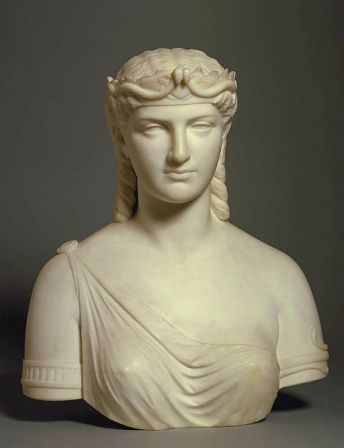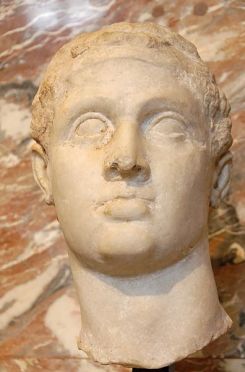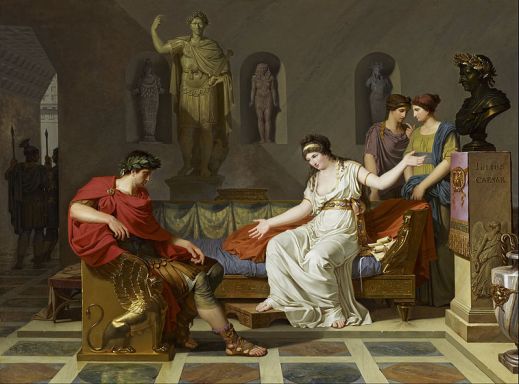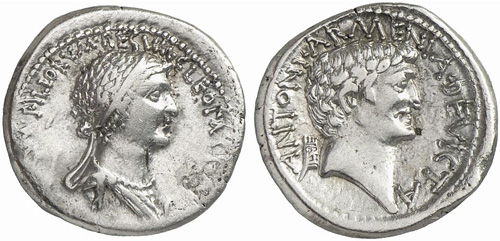
One of the most well-known names in history is that of a woman who ruled Egypt a few thousand years ago. Cleopatra and her enduring fame can still be seen in pop culture, especially in film. Her life was full of power, intelligence, romance, and tragedy. Aside from the fact that she ruled Egypt, what more can we learn about her? Where did she come from and who were her ancestors? What talents and abilities did she display as a leader? How is she depicted in pop culture and does that reflect what evidence from antiquity seems to say about who she was?
Origins

Colloquially known as Cleopatra, her full name was Cleopatra VII Thea Philopator. She was born in 69 BC and her father was Ptolemy XII Auletes. It is unclear who her mother was (Jones, 2006, p. xii). At the age of eighteen Cleopatra came to power alongside her brother after the death of their father in 51 BC (Walker, 2001, p. 6). They came to power because the Ptolemaic dynasty inherited the rule of Egypt after the death of its conqueror Alexander the Great.
Cleopatra: Pop Culture, Art, and Race
Understanding the art that has been inspired by the life of Cleopatra and how it depicts her might be an effective way to understand how she has managed to stay in the minds of the general population for more than two thousand years. Much of the art surrounding Cleopatra focuses on the more dramatic periods of her life.
One of the most famous pieces of art inspired by Cleopatra is the play Antony and Cleopatra written by William Shakespeare. The play depicts “the tragic story of the passionate lovers’ fatal bid for power against the calculating Octavian” (Walker, 2001, p. 7). There have been dozens of portrayals of Cleopatra in film over the last century, but perhaps none are more famous than that of Elizabeth Taylor in the 1963 film Cleopatra. A financial and critical disaster, the film relies heavily on a depiction of Cleopatra that focuses on her beauty and sex appeal.
Unfortunately this appears to be a common depiction of Cleopatra. As Margaret Miles writes in Cleopatra: A Sphinx Revisited (2011), “The legendary Cleopatra the public knows – the passionate, infinitely various woman of Shakespeare’s Antony and Cleopatra and the stylized beauty of the 1930s and 1960s films – has little to do with the historical Cleopatra” (p. 21).
Race
Portrayals of Cleopatra by white actresses, like Elizabeth Taylor or Angeline Jolie in the 2004 film Alexander, also bring into question the issue of Cleopatra and her racial makeup. She is nearly always portrayed as white, which has caused push-back from some historians like Joel Augustus Rogers and John Henrik Clarke, who claim that Cleopatra might have been black because there are two unknowns in her lineage: her mother and grandmother (Jones, 2006, p. 280-281). This leads to the speculation that “one or both of these ancestors were members of Egypt’s native population” (Jones, 2006, p. 279). The argument which results is that depicting Cleopatra as white cements her status as “the recycled fantasy of white culture” (Royster, 2003, p. 4). It is possible that depicting Cleopatra as a beautiful white woman might have contributed to her appeal in the Western world.
Before the invention of film-making, depictions of Cleopatra in paintings were a popular way of spreading her image, especially by 18th and 19th century European painters. Like their film counterparts, these paintings tend to focus on the more dramatic periods of her life rather than her many abilities and achievements. They also often portray her as a white woman wearing European-style clothing.

In Death of Cleopatra by Jean-André Rixens from 1874, Cleopatra is seen laying in her bed after being bitten by an asp, which is how she is rumoured to have died (Kleiner, 2005, p. 2). Her skin is extremely pale while two darker skinned servants lay over her dead body.

Two paintings, both by Giambattista Tiepolo, depict the meeting of Cleopatra and Mark Antony. The first, Banquet of Cleopatra and Mark Antony at Tarsus from the 1740’s, depicts Cleopatra and Antony dining at Tarsus while they strategize an alliance between Egypt and Rome (Kleiner, 2005, p. 26). The second, The Meeting of Mark Antony and Cleopatra from 1746-47, is a pre-cursor to the first and shows the arrival of Cleopatra at Tarsus. In both images she is pale with blonde hair and wears a European-style dress.

The painting Cleopatra and Octavian by Louis Gauffier from 1787-88 depicts Cleopatra yet again as a pale woman, this time with dark hair. She is sitting on a sofa speaking with Octavian.
These paintings highlight a problem which persisted when Cleopatra was put on film. Much of the focus is on her beauty and sex appeal, and many of the paintings focus only on the more dramatic periods of her life. This simplistic image of Cleopatra does not do her justice as ancient sources seem to show that she had many other talents and abilities.
Ancient Sources: The Real Cleopatra?
To gain a deeper understanding of Cleopatra it is important to look at sources from antiquity rather than depictions of her from the 18th century to modern day.
Written Sources
While modern depictions tend to focus on her beauty, ancient sources often speak of her charisma. This is noted by Plutarch in Life of Antony. He writes:
For indeed her own beauty, as they say, was not, in and of itself, completely incomparable, nor was it the sort that would astound those who saw her; but interaction with her was captivating, and her appearance, along with her persuasiveness in discussion and her character that accompanied every interchange, was stimulating. (Plutarch, Life of Antony 27.2-4. trans. Jones 2006, p. 32-33)
Cassius Dio references her beauty but also notes her charisma, writing in Roman History that “she knew how to use her charms to be attractive to everyone. Since she was beautiful to look at and to listen to, she was able to captivate everyone, even a man tired of love and past his prime” (Dio, Roman History 42.34.3 trans. Jones, 2006, p. 56).
Cleopatra was not only charming, but also a skilled negotiator. She spoke multiple languages which helped her develop this skill. This is one of the things she became well respected for as the leader of Egypt. Plutarch writes in Life of Antony:
Pleasure also came with the tone of her voice; and her tongue was like a many-stringed instrument: she could turn it easily to whichever language she wished and she conversed with few barbarians entirely through an interpreter, and she gave her decisions herself to most of them, including Ethiopians, Troglodytes, Hebrews, Arabians, Syrians, Medes, and Parthians. She is said to have learned the languages of many others also, although the kings before her did not undertake to learn the Egyptian language, even though some of them had abandoned the Macedonian dialect. (Plutarch, Life of Antony 27.2-4. trans. Jones, 2006, p. 33-34)
Depictions of her beauty aside, her general intelligence was also noted. Jones notes a piece written by Al-Mas’udi in the 10th c. AD which says that “she was wise, tried her hand at philosophy and was a close companion to wise men. She has works, both bearing her name and ascribed to her, of medicine, magic, and science, known by those versed in medicine” (Jones, 2006, p. 271).
Artifacts

Cleopatra had many things made in her image. Like most other elites her face was on coinage. A silver Denarius from 32 BCE depicts Cleopatra and Mark Antony (Miles, 2011, p. 57). On the coin Cleopatra has a hooked nose, which might not be representative of her actual looks. Walker notes that “like her contemporaries on the world stage, Cleopatra changed her image to suit her political ambitions. Her coin portraits vary (and not according to age) from sweet princess through Hellenistic Greek queen to dominant ruler” (Walker, 2001, p. 7).
A statue depicting Cleopatra wearing a wig and a headdress was found, and likely made, in Rome (Jones, 2005, p. 17). This shows the extent of her travels and influence over not just Egypt, but the Roman world as well, especially considering her affiliations with Caesar and Mark Antony.
Her beauty likely influenced the women of Rome as well. A statue from 40-49 BCE shows a Roman woman wearing a similar hairstyle and dress as Cleopatra. Diana Kleiner explains that “fashion statements like pearl earrings and sectioned hairstyles could be put on and taken off at will. It is also conceivable that Republican women in Rome commissioned Cleopatra-like portraits of themselves, even though they never would have dared to appear in the queen’s guise in public” (Kleiner, 2005, p. 278).
Death
It is theorized that she committed suicide at the age of 39 by allowing an asp to bite her (Jones, 2006, p. 180). This happened a year after losing the Battle of Actium.
Conclusion
Cleopatra is one of the most famous women from antiquity for good reason. Unfortunately her ability to speak multiple languages, negotiate, and talents as a leader are often cast aside in art and pop culture in favour of more dramatic aspects of her life. These include her beauty, charm, and romantic affiliations, notably with Mark Antony. It seems, based on ancient sources, that the real Cleopatra was more than simply mysterious and charismatic. Her effect on Alexandria and Egypt as a whole is undeniable. As author Prudence Jones writes, “so strong was her personality that Cleopatra came to represent Egypt itself” (Jones, 2011, p. xi).
References
Jones, P. J. (2006). Cleopatra: A sourcebook. Norman, OK: Univ. of Oklahoma Press.
Kleiner, D. E. (2005). Cleopatra and Rome. Cambridge, MA: Belknap Press of Harvard University Press.
Mankiewicz, J. L. (Director), & Mankiewicz, J. L., MacDougall, R., & Buchman, S. (Writers). (1963). Cleopatra [Motion picture]. USA: Twentieth Century Fox.
Miles, M. M. (2011). Cleopatra: A Sphinx Revisited. University of California Press.
Royster, F. T. (2003). Becoming Cleopatra the shifting image of an icon. New York: Palgrave Macmillan.
Stone, O., Kyle, C., & Kalogridis, L. (Writers), & Stone, O. (Director). (2004). Alexander [Motion picture]. USA: Intermedia Films.
Walker, Susan (2001). Cleopatra: From History to Myth. History Today, 51(4), p. 6-7.
Miles, M. M. (2011). Cleopatra: A Sphinx Revisited. University of California Press.
This is a very good and well-sourced article. I do want to point out that Angelina Jolie never played Cleopatra VII, certainly not in the film Alexander (2004) which is about a man who lived about three hundred years before the queen… She was rumored, however, to be in a Cleopatra film project based on Stacy Schiff’s popular history work, for many years. Leonor Varela, a woman of color, played the queen in Cleopatra (1999). Like the real queen, Varela is of partial Syrian ancestry.
LikeLike